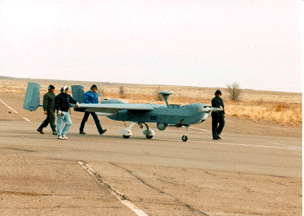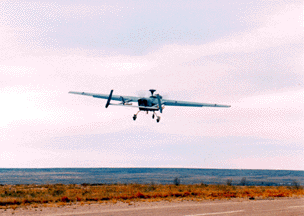

UAV Battlelab conducts first initiative
Released: Jan 28, 1998

A group of contractors escort a Hunter Unmanned Aerial Vehicle to the runway at the Ft. Sumner, N.M., airport in preparation for take-off. The UAV was testing its capability to detect enemy air defenses and transmit the locations of those threats to fighter jets. (Air Force photo by Capt. Patrick Hudson)

The UAV takes off for the Melrose Bombing Range for its first test in support of a UAV Battlelab Suppression of Enemy Air Defenses initiative. (Air Force photo by Capt. Patrick Hudson)

Controller Bill Henkel remotely pilots the Hunter UAV during the tests. (Air Force photo by Capt. Patrick Hudson)
|
by Capt. Patrick Hudson
53rd Wing Public Affairs
EGLIN AIR FORCE BASE, Fla. (AFNS) -- The Unmanned Aerial Vehicles Battlelab, of Eglin's 53rd Wing, put its first initiative to the test recently near Cannon Air Force Base, N.M.
The initiative, known as Suppression of Enemy Air Defenses, was conducted to determine whether a UAV can detect enemy air defenses and transmit the locations of these threats to fighter jets, thus enabling the fighters to destroy these targets.
"This was our first opportunity to test a battlelab initiative, and feel we successfully accomplished our goal of demonstrating a UAV's potential to detect enemy air defenses and transmit information about those defenses back to friendly aircraft," said Col. Joe Grasso, UAV Battlelab commander.
A Hunter UAV flew two-hour missions each day to conduct the initiative. The UAV carried a payload consisting of a direction-finding package to identify and locate potential threats, and an improved data modem to transmit gathered data to the fighter planes.
"The payload on the Hunter UAV performed very well during the demonstration," said Maj. Jim Shane, SEAD initiative program manager. "The direction-finding package identified the given threats, and the improved data modem worked exceptionally well. The improved data modem was probably the highlight of the demonstration."
The demonstration was conducted near the Melrose Bombing Range in the Pecos Military Operating Area in New Mexico.
"This is an outstanding location to conduct this type initiative," Grasso said. "We teamed up with the Air Force Operational Test and Evaluation Center at Kirtland AFB, N.M., which has done some UAV testing here before. There is a good infrastructure setup to work with at this site. We couldn't have been more pleased with the support we have received in making this demonstration a reality."
Now that the concept has been demonstrated, the next step is to conduct a modeling and simulation campaign. This will be followed by a final report which, once approved at wing- and headquarters-level, will be presented to the Air Force Board of Directors who will decide what further action, if any, should take place.



